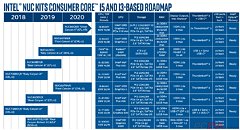- Joined
- Mar 25, 2009
- Messages
- 9,817 (1.71/day)
- Location
- 04578
| System Name | Old reliable |
|---|---|
| Processor | Intel 8700K @ 4.8 GHz |
| Motherboard | MSI Z370 Gaming Pro Carbon AC |
| Cooling | Custom Water |
| Memory | 32 GB Crucial Ballistix 3666 MHz |
| Video Card(s) | MSI RTX 3080 10GB Suprim X |
| Storage | 3x SSDs 2x HDDs |
| Display(s) | ASUS VG27AQL1A x2 2560x1440 8bit IPS |
| Case | Thermaltake Core P3 TG |
| Audio Device(s) | Samson Meteor Mic / Generic 2.1 / KRK KNS 6400 headset |
| Power Supply | Zalman EBT-1000 |
| Mouse | Mionix NAOS 7000 |
| Keyboard | Mionix |
Intel's Next Unit of Computing (NUC) systems have always offered a great deal of performance in a tiny form factor. Their current lineup which consists of Hades Canyon features Intel's 8th generation of processors and depending on model can also feature an AMD Radeon RX VEGA M graphics processor, that said, the vast majority of units utilize Intel's integrated graphics. The most potent these configuration is Intel's 100W 4c/8t i7-8809G with Radeon RX Vega M GH graphics. It delivers exceptional performance for the size, allowing users to play AAA games at high settings with stable frame rates.
Thanks to a member of the PC EVA forums we now have access to what appears to be a leaked Intel roadmap showcasing their Ghost Canyon X NUC systems. Set to debut in 2019/2020 Intel will be pushing multiple new CPUs for these systems including a 45W 8c/16t i9-9xxxH, 45W 6c/12t i7-9xxxH, and 45W 4c/8t i5-9xxxH. All three feature UHD graphics by Intel, however, what is most interesting there provisions for a single PCIe X16 slot. Now, in reality, the inclusion of a proper PCIe slot is unlikely, I would speculate due to the size that it is, in fact, an MXM slot which limits options to discrete mobile graphics processors which tend to be far more expensive for consumers. Still, more information is required before making any serious judgments one way or the other at this time.


Other than that the PCIe x16 slot being a bit suspect, the rest of the specifications at least have the appearance of being valid. Storage is handled by 2x M.2 slots, while I/O connectivity consists of; 8x USB ports, 2x Thunderbolt 3 + USB-C ports and 3x HDMI 2.0a ports maximum. It is also equipped with two memory slots that support DDR4 2400/2666 memory up to 64 GB maximum. The only other discrepancy appears to be the HDMI 2.0a standard, which differs from previous units which supported HDMI 2.0b. That said, the difference between the two is quite minimal with 2.0b adding support for Hybrid Log Gamma (HLG) which is a part of the HDR standard that is not as widespread as the more common HDR10 and Dolby Vision standards.
View at TechPowerUp Main Site
Thanks to a member of the PC EVA forums we now have access to what appears to be a leaked Intel roadmap showcasing their Ghost Canyon X NUC systems. Set to debut in 2019/2020 Intel will be pushing multiple new CPUs for these systems including a 45W 8c/16t i9-9xxxH, 45W 6c/12t i7-9xxxH, and 45W 4c/8t i5-9xxxH. All three feature UHD graphics by Intel, however, what is most interesting there provisions for a single PCIe X16 slot. Now, in reality, the inclusion of a proper PCIe slot is unlikely, I would speculate due to the size that it is, in fact, an MXM slot which limits options to discrete mobile graphics processors which tend to be far more expensive for consumers. Still, more information is required before making any serious judgments one way or the other at this time.


Other than that the PCIe x16 slot being a bit suspect, the rest of the specifications at least have the appearance of being valid. Storage is handled by 2x M.2 slots, while I/O connectivity consists of; 8x USB ports, 2x Thunderbolt 3 + USB-C ports and 3x HDMI 2.0a ports maximum. It is also equipped with two memory slots that support DDR4 2400/2666 memory up to 64 GB maximum. The only other discrepancy appears to be the HDMI 2.0a standard, which differs from previous units which supported HDMI 2.0b. That said, the difference between the two is quite minimal with 2.0b adding support for Hybrid Log Gamma (HLG) which is a part of the HDR standard that is not as widespread as the more common HDR10 and Dolby Vision standards.
View at TechPowerUp Main Site



